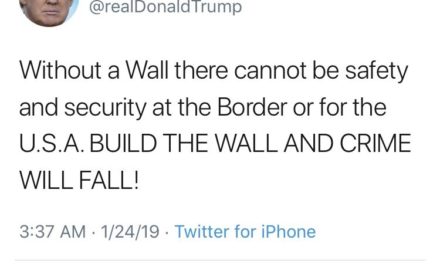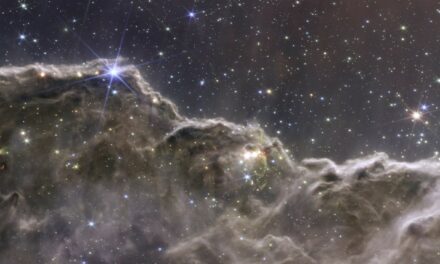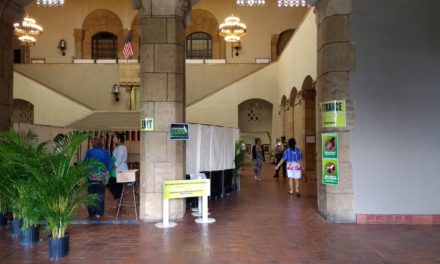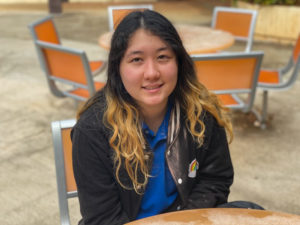By Lexus Yamashiro | Staff Writer
After taking several semesters of as little as just one class at KCC, 26-year-old Maria McClellan began to notice the challenges she often faces while getting around and entering buildings on campus. Born with Morquio Syndrome, a rare birth defect that has stunted McClellan’s growth and limits her ability to walk, the Vermont native’s reliance on her motorized wheelchair and 2-year-old service dog, Shadow, can only help her so much when attempting to enter buildings on her own.
Taking classes that are located in buildings such as Olonā where there is no automatic door opener (ADO), McClellan finds herself waiting at these entrances for as long as 10 minutes or until she can flag down someone passing by to receive assistance in opening the door.
“It is challenging, there’s only a few buildings that are easy to get into,” McClellan said. “I have no problem asking [for help], but it’s just about being independent too.”
With a total of 20 buildings spread throughout the campus, seven out of 10 buildings that are enclosed have no ADOs or automatic sliding doors; these buildings include ʻIliahi, ʻŌhelo, Olonā, Naio, Mānele, Manono, and Olopua. Although these buildings are considered compliant under the Americans with Disabilities Act (ADA) from the time they were developed, McClellan believes that improvements can be made to keep the campus updated with the current ADA laws.
“I’m not saying that we have to change the laws … [but] I think we should go beyond the law,” she said. “If you go beyond it, it just shows that … we’re not just going by the books but we want to be accessible for somebody deaf, somebody blind, [and] somebody who has a hard time walking.”
Back in March 2014, McClellan and former student David Oneha sat down with KCC administrators to express their concerns about the campus’s accessibility situation, their primary focus being that an ADO should be installed onto the entrance of the Disabilities Support Services Office (DSSO). As students who use wheelchairs, the two found it imperative that the office should have an ADO to grant easier access for students who are unable to open doors by themselves. Eventually, the campus went forward with the idea, and McClellan was pleased to see the installment just a few months after the idea was mentioned.
Although McClellan and Oneha were able to initiate this addition for the campus, the removal of an ADO occurred during the Spring 2017 ʻŌhiʻa Lobby Renovation on the ground floor in which part of the project remodeled the entrance to the KCC bookstore, eliminating the ADO that was once there. When the campus faces projects that involve accessibility points, Vice Chancellor for Administrative Services Brian Furuto said that KCC administrators and architects meet to discuss these plans that are to be reviewed and approved by the Disability and Communication Access Board (DCAB).
“Right now, according to the latest ADA law, it’s not a requirement of ADA law to have such a button,” Furuto said. “While it’s a great feature to have, the difficult part about our campus is most of these buildings were built in a period of the early 1980s to the late 1980s, early ’90s.”
Furuto explained that the process of having an ADO installed can be challenging since the door that it would be placed upon may have to be switched out completely. Contractors would have to check for a power source, install hardware and locking mechanisms, and have the correct door in order for an ADO to function properly.
KCC has plans for the bookstore itself to go through renovations in Summer 2019. Recognizing that the lack of an ADO for this particular entryway is affecting students, Furuto said that consideration to have the button reinstalled will most likely be discussed amongst the administrative team when the project’s plans unfold further.
Besides the ADOs that significantly benefit many students, faculty, and staff on campus, elevators have been another helpful access point for students such as Kekoa Minoyama. In his second year of college at KCC, the 19-year-old Liberal Arts major has been using the elevators in buildings such as ʻIliahi, Kalia, and Olonā at least once a day to get to class due to a condition he was born with that affects his muscles.
“My disability basically limits, or prohibits, the amount of energy I have throughout the day,” said Minoyama, who did not want to disclose the name of his condition. “So, having the elevators really helps save up enough energy for me to go on throughout the day.”
Minoyama described that his condition allows him to walk through the campus from ʻIliahi to parking lot A, but leaves him weak once he reaches the top of the school. Having to take a minute break or to replenish his body with a snack or some water is what Minoyama often does to keep himself from falling.
In Fall 2017, an elevator in the Kokiʻo building went out on Sunday, Oct. 29, but the campus was unaware of the situation until Auxilary Services sent out an email on Tuesday, Oct. 31. Minoyama was unaffected by this incident, but he expressed that he could understand how others may have felt that day.
“It wouldn’t affect me too much since I can still use the staircase, but in times of that actually happening … I would imagine they were quite frustrated and that would be on the school’s part,” Minoyama said.
Although Minoyama feels safe on campus, he believes that accessibility is still lacking. He and McClellan shared that the maps located around campus should be updated to provide a visual of which routes are accessible to take, especially for those in a wheelchair or with an injury. While DSSO prints these maps with highlighted pathways, McClellan said that this map will be unknown to those who step foot on campus unless if they visit this office in ʻIlima 107.
While the campus encourages students to speak up regarding this issue, Furuto explained that these changes will be challenging to fulfill unless if there is enough money to cover the costs.
“We have a Deferred Repair and Maintenance backlog, and very simply what that means is we’re behind in the maintenance of our buildings,” Furuto said. “In any case, we need to prioritize, and there’s often times there’s just no money left to do certain projects.”
A Long Range Development Plan (LRDP) discussion session that is held every 10 years will be organized on campus later this year and will be open to students, faculty, and staff to attend. The LRDP will outline the goals that KCC hopes to achieve in the long run, including the topic of improving accessibility.
As the campus moves forward to improve accessibility on campus, projects such as improving parking lot B is on the campus’s priority list due to tree roots uplifting the grounds and scattered unevenness. Until these projects unfold, the campus hopes that safety will improve as more ideas come forth.
“We rely on our counselors and DSSO office [because] these individuals are helping students [and] all manners of students,” Furuto said. “While we may not be able to talk to a student every single day, they do. If [a student] has concerns or issues regarding the facilities or accessibility, then hopefully we’ll get wind from them because [the student] might not know who to go to.”






